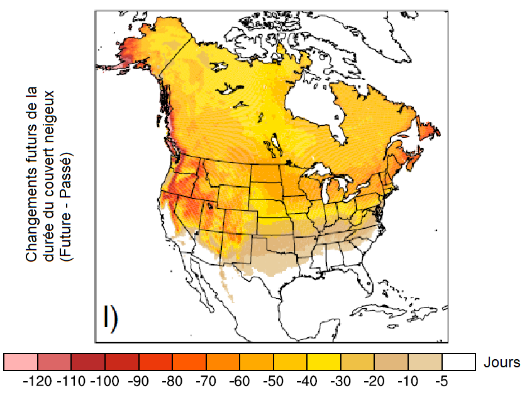Snow cover
Climate projections indicate that over the coming decades, winters in North America and Canada will gradually change, with higher temperatures and a reduction in the length of the season.
In Canada, it is very likely that snow cover will decrease until mid-century. Much of the south of the country is expected to see a 5 to 10 percent decline in snow cover per decade, while northern regions are expected to see smaller changes.
Projected changes in Quebec
Like in southern Canada, southern Quebec will experience shorter and less snowy winters.
Climate projections indicate that the duration of snow cover could decrease by 40 to 50 days across Quebec by the end of the century. The extreme south of Quebec could experience a reduction in its snow cover of more than 50 days (Figure 3).
By the end of the century, it is also projected that the percentage of water equivalent in snow could increase by up to 10% in the far north of Quebec. However, it will decrease by 0 to 10% in most of Quebec, and even up to 30% in the south of the province (Figure 4).

Figure 3: Future changes in the number of days of snow cover in North America. Reference: from Figure 4 in McCrary (2022) - simulation with CORDEX at 12 km

Figure 4: Future changes in the percentage of snow cover in North America (%). Reference: from Figure 5 in McCrary (2022) - simulation with CORDEX at 12 km
Projected changes for Quebec’s alpine ski areas
As part of the PINS research project, simulations were studied for southern Quebec in a zone that was specifically defined for this study, where alpine ski resorts are located.

Figure 5: The southern Quebec administrative regions with alpine ski areas (Bresson et al., 2024)
This project is facilitating access to historical and future climate data on snow cover throughout Quebec at a resolution of around 10 km. Users and decision-makers in many sectors and industries now have a wider range of climate information to integrate into their adaptation plans.
The PINS project considered two greenhouse gas emission scenarios: a moderate scenario (RCP 4.5) and a high emissions scenario (RCP 8.5). The simulations were carried out for two future periods, 2041-2070 and 2071-2100. The mean as well as the minimum and maximum values were analyzed.
The results of the climate projections from the PINS project indicate that for the entirety of Quebec’s alpine ski areas, the snow cover will experience the following changes:
A general decrease in snow cover: Snow cover duration is projected to decrease by 16.4 days on average for the moderate scenario (RCP 4.5) and by 20.1 days for the high emissions scenario (RCP 8.5) by 2041-2070.
Reduction of the season of continuous snow cover: The period of continuous snow cover is expected to shorten as snow starts falling later and melts earlier. For the 2041-2070 horizon, this period will decrease by approximately 10 days, with a delay of 8.1 days in the start of the season and the end of the season coming 8.6 days earlier, based on the moderate scenario (RCP 4.5).
Decrease in maximum snow water equivalent (SWE): The maximum SWE will decrease throughout the region, with a more marked reduction in the south. This reduction is also projected to be more intense under the high emissions scenario (RCP 8.5) than the moderate one (RCP 4.5).
Figure 6: Increase in the number of days without natural snow cover in Quebec’s alpine ski areas between November and March (Bresson et al., 2024).
In the south and in the St. Lawrence Valley, the decrease in snow cover is projected to become more pronounced as we approach the end of the century. This decrease is also more significant with the high emissions scenario (RCP 8.5) than with the moderate one (RCP 4.5).
In the rest of Quebec’s ski areas, the decrease in snow cover will be less marked. The least affected areas are located in the north, as well as in certain mountain ranges such as the Charlevoix, Monts-Valin and Chic-Chocs ranges.